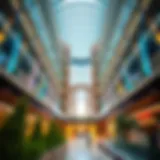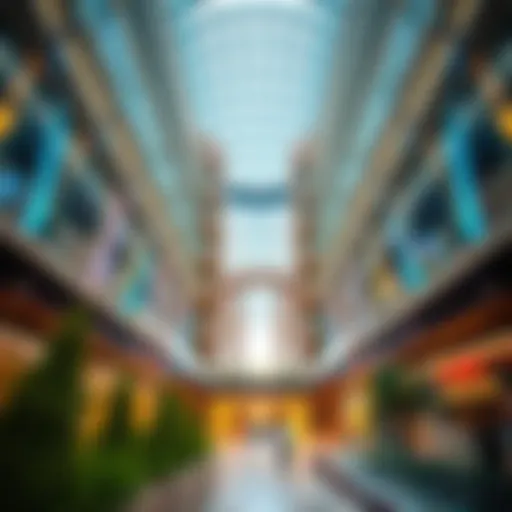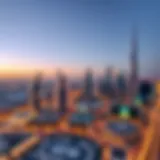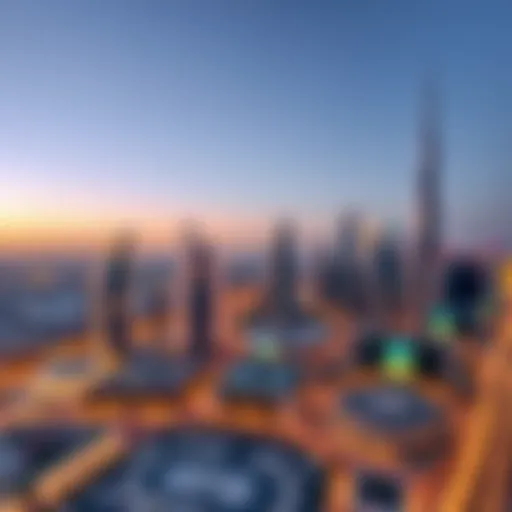Discovering Bastakiya: Dubai's Historic Heritage Site
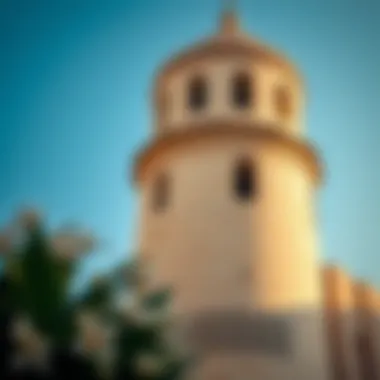

Intro
Bastakiya is not just a name, but a symbol of Dubai's past, reflecting the rich tapestry of Emirati culture and architecture. Nestled along the banks of Dubai Creek, this historic district whispers stories of a time when trade routes thrived and traditional life flourished. As you wander through its narrow lanes, you see wind towers standing tall—a testimony to ingenious design that kept homes cool long before modern air conditioning came into play. The adobe buildings, with their intricate latticework, exude an otherworldly charm, as if they’ve been plucked from the pages of history.
The juxtaposition of Bastakiya against the soaring skyscrapers of modern Dubai paints a vivid picture of the city’s evolution. Here, the essence of Emirati life is preserved in artisans’ shops, art galleries, and cultural institutions, inviting both locals and visitors to step back in time. This district serves as a bridge linking the ancient traditions of the past with the relentless march of modernity.
In exploring Bastakiya, one can appreciate the district's contributions to both tourism and real estate. As the city continues to develop, this area stands out, offering a unique slice of historical significance that appeals to investors and homebuyers alike. From its architectural marvels to its cultural offerings, Bastakiya is a living museum, showcasing the resilience and richness of Dubai's heritage in a fast-paced urban environment.
Preamble to Bastakiya
Bastakiya, also known as Al Fahidi Historical Neighborhood, stands as a testament to Dubai's rich cultural heritage and history. This historic district offers a glimpse into the life of the early Emiratis, showcasing their architectural prowess and the community spirit that thrived in these narrow lanes. Investors, property managers, and anyone interested in real estate will find that understanding Bastakiya’s significance is crucial not only for appreciating its aesthetic appeal but also for grasping its potential in today’s urban setting.
Historical Background
Originally established in the late 19th century, Bastakiya was a renowned trading hub. The area derived its name from the town of Bastak in Iran, from where many merchants migrated to Dubai. They brought with them not just their trade but also their cultural influences, which still echo through the buildings and alleyways today.
The neighborhood was primarily inhabited by Persian merchants who engaged in lucrative trade in textiles, pearls, and spices. The architecture of Bastakiya features wind towers, which were ingeniously designed to keep the houses cool in the sweltering desert heat. These towers, along with the intricate plaster work in the walls, tell a story of a sustainable lifestyle long before modernity crept into the region.
As Dubai transformed from a modest fishing village into a bustling metropolis, Bastakiya faced the threat of disappearing amidst the rapid development schemes that often engulf historical areas. However, local initiatives and governmental efforts have been made to conserve this unique area, proudly presenting its history alongside Dubai's modern advancements.
Cultural Importance
The cultural significance of Bastakiya extends beyond its charming architecture. It symbolizes the resilience and resourcefulness of the Emirati people. Bastakiya serves as a center for art and culture, attracting artists and historians who wish to delve deeper into the UAE’s vibrant past.
Local museums, like the Dubai Museum, located in the historic Al Fahidi Fort, and art galleries such as the Majlis Gallery, offer educational experiences to visitors and residents alike. These institutions not only preserve the history but also foster community connections by regularly hosting cultural events, workshops, and exhibitions.
Moreover, Bastakiya holds annual cultural festivals that celebrate Emirati traditions, food, and art. These events offer a platform for local artisans and musicians, allowing them to showcase their talents and contribute to the tapestry that is Emirati heritage. For those investing or buying property in or around the area, aligning with these cultural movements can enhance community ties and floor plans that respect local traditions.
In summary, the exploration of Bastakiya is not merely an observation of the past but a meaningful engagement with a living, breathing community that respects its history while stepping into the future. Investors keen on real estate in this district will discover opportunities that intertwine financial prospects and cultural richness.
"Bastakiya embodies the essence of Dubai’s transformation, holding onto its past even as it embraces the future, making it a worthwhile chapter in the story of modern urbanization."
For further insights into Dubai's rich history, consider visiting Wikipedia, or check out Britannica for a comprehensive view of the city’s development.
Architectural Features
Bastakiya's architectural features reflect a unique blend of art and functionality, offering visitors a glimpse into a time when every building had a purpose meticulously aligned with the environment and lifestyle of its inhabitants. This section explores how these structures not only served residential and commercial needs but also embodied the cultural and historical essence of Dubai. The design elements found here stand out as representations of the rich Emirati heritage, making them a focal point for investors, real estate agents, and homebuyers who appreciate properties with character and history.
Wind Towers: A Signature of Bastakiya
One of the most striking elements of Bastakiya’s architecture is the wind tower, locally known as barjeel. These towers are a traditional form of passive cooling that showcases the ingenuity of the local builders in adapting to the harsh desert climate. Standing tall above the narrow alleys and low structures, wind towers capture the cooler breezes from higher altitudes, funneling them down into the living spaces below. This not only kept homes significantly cooler but also reduced the reliance on artificial cooling methods.
The design of the wind towers is not mere aesthetics; it reflects an understanding of aerodynamics and natural airflow. For potential homeowners and real estate professionals, these features can be appealing as they symbolize sustainable living and energy efficiency. Wind towers represent the marriage of form and function, a must-have for buyers interested in eco-friendly architecture that aligns with modern values of sustainability.
The wind tower is more than a mere architectural feature; it's a symbol of the cultural identity of Bastakiya.
Historically, these towers were integral to traditional Emirati life, serving as a testament to the skills of craftsmen of the era. If one looks carefully, they may notice the variations in design among the towers – some are quadrangular, while others take on an octagonal shape. This variety provides insight into the personal touch of individual builders and the evolution of design preferences over time.
Traditional Building Materials
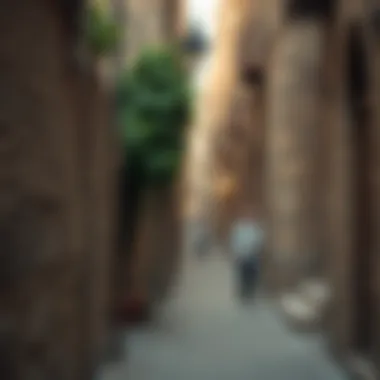

The building materials used in Bastakiya are another vital aspect of its architectural charm. Traditionally, houses were constructed with coral stone, mud, and plaster, all sourced locally. This not only made construction cost-effective but also harmonized the buildings with the surrounding environment. Using materials that naturally occur in the region helps create a lasting bond between the structures and their historical context.
Coral stones, derived from the nearby reefs, lend unique textures and colors to the buildings. This is especially noticeable in some of the older structures where the raw, unfinished surfaces still whisper stories of their past. Meanwhile, mud bricks offer thermal properties that are ideal for the desert climate, acting as insulators and keeping interiors cool.
For real estate investors and property managers, understanding the significance of these materials can provide a deeper appreciation of the aesthetic and practical value in properties within Bastakiya. Such elements open discussions not only on aesthetic renovation but also on restoration efforts that could maintain the cultural heritage embedded within these walls.
For more on the cultural significance and architectural wonders of Bastakiya, you can visit Dubai Culture and Dubai Tourism.
Cultural Institutions in Bastakiya
Cultural institutions in Bastakiya play a crucial role in connecting the past with the present, acting as gateways to understanding the rich tapestry of Emirati heritage. These establishments provide insights into local art, history, and the cultural evolution of Dubai, making them indispensable for both tourists and residents alike. For anyone keen to dive deeper into the local culture, the various museums, galleries, and festivals of this historic district offer a well-rounded experience.
Museums and Galleries
Dubai Museum
The Dubai Museum, housed within the Al Fahidi Fort, is more than just a building; it's a time capsule of the region's history. This museum stands out for its capacity to transport visitors back in time—to the days before skyscrapers dominated the skyline. It serves a pivotal role in preserving the essence of Dubai's heritage, showcasing artifacts that narrate tales of the city's transformation from a humble trading post to the thriving metropolis it is today.
One of the key characteristics of the Dubai Museum is its engaging exhibits that often include life-sized dioramas depicting traditional life on the Arabian Peninsula. This adds a tangible layer to the historical narrative, engaging visitors more effectively. For anyone interested in how Dubai's culture was shaped, it’s a popular choice as it highlights the significance of trade and social structure in its narrative.
A unique feature of the Dubai Museum is its focus on the pearl diving industry, a cornerstone of Dubai's initial economy. For those looking to understand where Dubai started, this aspect provides a fascinating glimpse into the local ancestry and their pursuits. However, a disadvantage might be that it can get crowded during peak touring seasons, potentially diminishing the experience for some visitors.
Majlis Gallery
The Majlis Gallery contributes significantly to the cultural fabric of Bastakiya. It is known for its diverse collection of contemporary art, focusing on local and regional artists. What makes this gallery stand out is its commitment to fostering an appreciation for modern art while also encouraging dialogues about Emirati culture.
This gallery is a beneficial stop for those who want to see the intersection of tradition and innovation. A key characteristic of the Majlis Gallery is its embrace of various art forms, including painting, sculpture, and photography. This not just showcases artistic talent but also reflects the dynamic nature of Dubai's cultural narrative.
One notable aspect is the exhibitions they organize, often featuring collaborative works by artists. These events engage the community, making art accessible and relevant. However, as it's focused primarily on contemporary works, those seeking more traditional art may find the selection somewhat limited. Still, the refreshing perspective on local culture that the gallery offers makes it a worthwhile visit for any cultural enthusiast.
Cultural Events and Festivals
Bastakiya comes alive during various cultural events and festivals throughout the year. They highlight local traditions, arts, and community spirit. Events like the Dubai Art Season and the Gulf Film Festival play a vital role in enhancing cultural appreciation. This district not only educates but also cultivates a sense of community.
With its deep-rooted culture and ever-evolving artistic scene, Bastakiya's cultural institutions serve as the backbone of the historical district, ensuring that it remains a vital part of Dubai's ongoing story. For anyone who aims to experience the convergence of the past and present, these institutions provide a robust framework for understanding what makes Bastakiya a historical gem.
Evolution of Bastakiya
The journey of Bastakiya is one that mirrors the broader narrative of Dubai itself — a transformation from humble beginnings to a bustling hub of tourism and commerce. The importance of this evolution lies not only in its historical significance but also in how it has shaped the identity of modern Dubai. Bastakiya, known for its narrow lanes and traditional architecture, offers a striking contrast to the glittering skyscrapers that now dominate the skyline.
As we delve into Bastakiya's evolution, we explore the dynamic aspects that have turned this once unassuming trading post into a vibrant cultural landmark. This evolution is characterized by several key elements, including:
- The shift from a primary focus on trade to its current role as a cultural attractor.
- The ongoing restoration initiatives that highlight and preserve its historical significance.
- The interplay between local heritage and the influx of modernity that brings fresh opportunities and challenges.
This nuanced transition illustrates the impact of a community's commitment to preserving its roots while adapting to the demands of progress and tourism.
From a Trading Post to a Tourist Attraction
In its early days, Bastakiya was primarily a trading post that facilitated commerce between the Persian Gulf and beyond. The location, adjacent to Dubai Creek, was significant for merchants who navigated these waters carrying goods such as textiles, spices, and pearls. The air of bustling market life infused the area, showcasing local craftsmanship and trade prowess.
As time passed, the changing economic landscape heralded a shift in the district's identity. The oil boom in the 20th century repositioned Dubai as an international business center. Recognizing the need to cater to tourism, Bastakiya began its reinvention as a focal point for visitors eager to understand the rich Emirati culture. The blend of shops selling traditional artifacts, art galleries presenting local artists, and cafés offering Arabian coffee has turned Bastakiya into a must-visit destination for tourists.
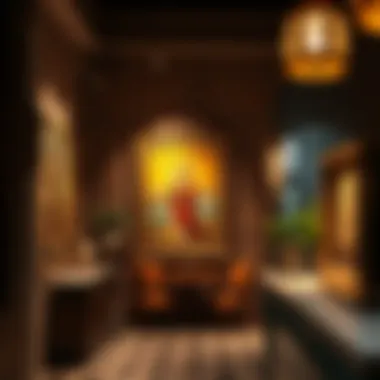

This transformation did not happen overnight; it was the result of conscious efforts by local authorities to highlight the historical treasures of the district. By developing infrastructure and promoting cultural events, the area has successfully transitioned into a paradise for those looking to explore the ancient aspects of Dubai.
Restoration and Preservation Efforts
Recognizing the cultural value of Bastakiya, extensive restoration and preservation efforts have been implemented in recent years. These efforts are vital for maintaining the authenticity of the area's historical architecture and ensuring that future generations can appreciate its legacy.
Key initiatives include:
- Repurposing Traditional Structures: Old buildings have been carefully restored to house galleries and museums, breathing new life into the architecture while preserving its historical essence.
- Community Engagement: Local residents and artisans have been involved in restoration projects, fostering a sense of ownership and connection to the district's past.
- Sustainability Practices: The integration of modern sustainable practices in the restoration process helps ensure that these historical sites can endure the pressures of contemporary life.
The diligence shown in restoration practices highlights a community's respect for its roots. It serves as a narrative that connects the past with the future, ensuring that traditions aren’t just relics but living parts of daily life.
In summary, the evolution of Bastakiya from a modest trading post to a vibrant tourist attraction encapsulates the spirit of Dubai. Its ongoing restoration efforts signify a commitment to preserving the cultural heritage that forms the backbone of this unique Emirati locale.
Bastakiya's Role in Modern Dubai
Bastakiya holds a vital place in the tapestry of Dubai's contemporary landscape. This historic enclave, steeped in tradition, serves not just as a window into the past, but also as a significant influencer on the city's present and future developments. The juxtaposition of the ancient and the modern creates a space where history is not merely preserved but integrated into modern life, making it an essential part for those looking at real estate investment or cultural tourism. Understanding this role helps in comprehending how Bastakiya shapes the identity of Dubai and its broader cultural narrative.
Contrasting Old and New
Bastakiya stands as a stark reminder of a bygone era amidst the rapid urbanization seen elsewhere in Dubai. The narrow lanes and wind towers evoke images of a time when trade and tradition weaved the social fabric of the area. As you wander through its alleys, one can’t help but feel the soul of the Emirati culture that flourished here.
At the same time, modernity looms large just outside its borders. Skyscrapers and luxury malls dominate the skyline. However, this contrast is more than visually striking; it serves multiple purposes.
- Cultural Reflection: Visitors often find solace in Bastakiya, contrasting their high-speed escapades in modern Dubai with the tranquility of the past. This reflection nurtures a deeper understanding of where the city has come from, echoing its growth in harmony with tradition.
- Tourism and Real Estate Appeal: The allure of residing near such a culturally rich area can drive property values up. Investors see potential in properties that stand close to this historical segment, where old-world charm meets contemporary conveniences.
Many residents appreciate the adjacent bustling lifestyle while enjoying the serenity found in Bastakiya. This balance adds layers of desirability, making the area a unique proposition for home buyers and real estate agents alike.
Impact on Real Estate Development
The impact of Bastakiya on real estate development in Dubai is noteworthy. With its significant historical context, properties in proximity to this area are often seen as premium assets. Investors recognize the value linked to Bastakiya's cultural heritage, which can enhance property attractiveness to both local and international buyers.
- Heritage Building Regulations: There are stringent regulations in place that protect the architectural integrity of Bastakiya. This means that new developments in its vicinity must respect the historical aesthetics, ensuring that the old blends gracefully with the new.
- Gentrification and Community Growth: While Bastakiya battles the challenges of modernization, it also serves as a catalyst for gentrification. Upgrades in infrastructure and amenities can revive the community, making it a hotspot for creative spaces, galleries, and boutique shops, which in turn, attract new residents.
- Cultural Investment: With cultural events and festivals being held in Bastakiya, the area not only becomes a tourist magnet but also increases overall real estate appeal. Investors often see the potential returns on their investments, knowing that the location can draw visitors and residents year-round.
In summary, Bastakiya's role in modern Dubai is pivotal. It illustrates a blend of heritage and progress that stands testament to the city’s commitment to preserving its identity while embracing innovation. For anyone delving into the real estate market here, an appreciation of this dynamic can provide insights that are both beneficial and enriching.
Visiting Bastakiya
When you're thinking about visiting Bastakiya, it’s not just about ticking a box off your travel bucket list. Bastakiya, known for its charming labyrinth of narrow alleys and beautifully restored buildings, serves as a portal to Dubai's rich past. Understanding the significance of this area can transform an ordinary stroll into a vibrant exploration of cultural heritage. Visitors here gain insights into traditional Emirati life, architectural marvels, and the fusion of old and new.
However, timing and planning your visit are crucial, as the experience can vary significantly based on when and how you decide to explore Bastakiya.
Best Times to Visit
There are three primary seasons to consider when planning your trip:
- Winter (November to March)
- Spring (April to May)
- Summer (June to September)
- The weather is generally milder, making it the best time for outdoor activities. Temperatures can drop to a pleasant 20°C (68°F) in the evenings.
- While the days start to warm up, evenings still hold some charm. However, daytime temperatures can reach soaring heights, so early morning visits are advisable.


- If you find yourself in Dubai during these months, it’s crucial to plan your visit for early mornings or late evenings. The oppressive heat can be difficult to manage, with temperatures well above 40°C (104°F) throughout the day.
Visiting during the cooler months allows you to truly soak in the unique atmosphere of Bastakiya, while the evenings provide a captivating backdrop as the ancient buildings are lit up. As the sun sinks low, the ambiance shifts, enhancing the beauty of your visit without the cumbersome heat.
Guided Tours and Experiences
For those looking to delve deeper into what Bastakiya offers, opting for guided tours is an excellent choice. These tours often come with a wealth of knowledge that casual visits might not provide. A well-organized tour can highlight America's culinary traditions, including a chance to taste local delicacies.
Something to consider:
- Local Culture Tours: These tours offer a unique perspective on the area’s heritage, often led by knowledgeable guides who share personal anecdotes and historical context.
- Photography Tours: The stunning architecture makes for excellent photography opportunities. Many guides specialize in capturing the essence of this historic district.
- Art Walks: Alongside the galleries, art walks often plunk you down the vibrant cultural hotspots of the area, allowing for a rich exploration of contemporary and traditional art.
Many of these tours can be booked through various platforms like Viator or local guides recommended on TripAdvisor. These experiences are suitable for all types of visitors, whether you are a keen photographer, a history buff, or someone who enjoys leisurely walks through stunning architecture.
By choosing to experience Bastakiya through guided tours, visitors not only navigate the logistics but also tap into the stories and histories that breathe life into each corner of this enchanting area.
Visiting Bastakiya is about more than seeing a site; it's about immersing oneself in the narrative of Dubai itself, where culture and history live on in every wall and alley.
The Future of Bastakiya
As we consider the future of Bastakiya, it’s evident that this historic area stands at a crossroads. Balancing the rich tapestry of its heritage with the relentless pace of modernity poses both challenges and opportunities. For investors and stakeholders, understanding how these factors will shape Bastakiya is crucial in tapping into its potential as a high-value asset in the ever-evolving landscape of Dubai.
Sustainability Initiatives
Sustainability is becoming the watchword in the development narrative of many historical districts worldwide, and Bastakiya is no exception. Recent initiatives aim at preserving the natural resources while retaining the cultural essence of the area. This includes:
- Energy Efficiency: Implementing solar panels discreetly on rooftops to promote renewable energy without disrupting the aesthetic integrity of the buildings.
- Water Conservation: Utilizing traditional methods like qannats—underground irrigation systems—to reduce water usage, thereby respecting the environment.
- Community Engagement: Involving local artisans and communities in sustainability discussions emphasizes maintaining authenticity and local practices in the face of modernization.
These efforts reflect not just an environmental consciousness but also a smart investment strategy. Property developers are recognizing that eco-friendly projects tend to attract more discerning clients, looking for both style and substance.
Potential Development Projects
Looking ahead, several development projects could greatly impact Bastakiya. Though the core of the district will remain protected, several initiatives are under consideration:
- Boutique Hotels: The introduction of boutique accommodations could cater to tourists seeking authentic experiences tied to history and culture. Thoughtfully designed, these hotels would enhance visitor numbers while providing economic benefits to the area.
- Cultural Centers: Establishments that host workshops and performances can emerge, showcasing local artists and preserving traditions. Such centers would enrich the cultural landscape and provide engaging purposes beyond mere tourism.
- Smart Infrastructure: Integrating smart technologies discreetly into amenities can uplift visitors’ experiences without disrupting the existing charm. This may include mobile applications for guiding tourists or improving local transportation systems connecting Bastakiya to wider Dubai.
As the city forges ahead into the future, Bastakiya's evolution must protect its roots while enabling growth. Striking that balance is paramount.
In closing, observant investors and property managers must remain vigilant about the pulse of the market and trends shaping Bastakiya's framework. It’s a dance between heritage preservation and modern amenities, ensuring that the heart of this district continues to beat vibrantly through time.
Ending
Bastakiya stands as a testament to Dubai's rich history and cultural evolution. As we've traversed through the historical underpinnings and architectural jewels that this district holds, it becomes clear that Bastakiya is not just a collection of old buildings; it embodies the spirit of a people and a time long past yet still influential today. Its significance stretches beyond mere aesthetics or tourism—it's about preserving a narrative that ties current generations to their roots.
Summary of Bastakiya's Significance
Bastakiya showcases an intricate balance between preserving traditional Emirati life and adapting to modern influences. Many investors and real estate enthusiasts should take note of how this historical district continues to lure both local and international visitors, emphasizing its strategic importance within the urban landscape. The wind towers, the labyrinthine alleyways, and cultural institutions provide a backdrop that enhances Dubai’s identity. Investing in or around this area isn't just wise; it's an investment in history itself. From art galleries like Majlis Gallery to the Dubai Museum, each institution contributes uniquely to the storytelling of Bastakiya, making it an essential stop for anyone wanting to grasp the breadth of Dubai’s cultural fabric.
Final Thoughts on Heritage Preservation
As we glance into the future, the importance of heritage preservation in Bastakiya cannot be overstated. Sustainable initiatives are on the rise, aiming not just to retain the structures of the past, but also to breathe new life into the experiences they offer. The balance of development and conservation is delicate but vital.
Protecting this district's essence means fighting against the tide of rapid modernization. Investors and property managers must consider not just the immediate gains from real estate projects but also their impacts on the community’s identity. By prioritizing heritage, the district can flourish as a vibrant hub that respects its roots while paving the way for contemporary lifestyles.
"In a rapidly changing Dubai, Bastakiya serves as a critical reminder of where we've come from and where we must go—holding the past while stepping into the future."
Every step taken to preserve Bastakiya is a step toward ensuring that future generations have a window into the past. It offers a rich tapestry of experiences, underscoring the essential link between cultural heritage and modern existence. Therefore, as stakeholders in this journey—be it investors, home buyers, or even renters—our role is to champion these efforts, ensuring that the stories of Bastakiya continue for years to come.








